
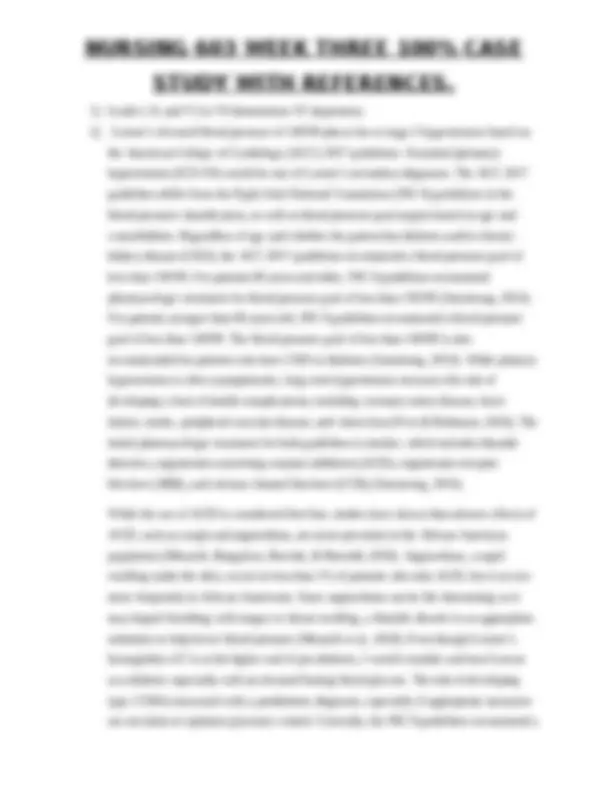

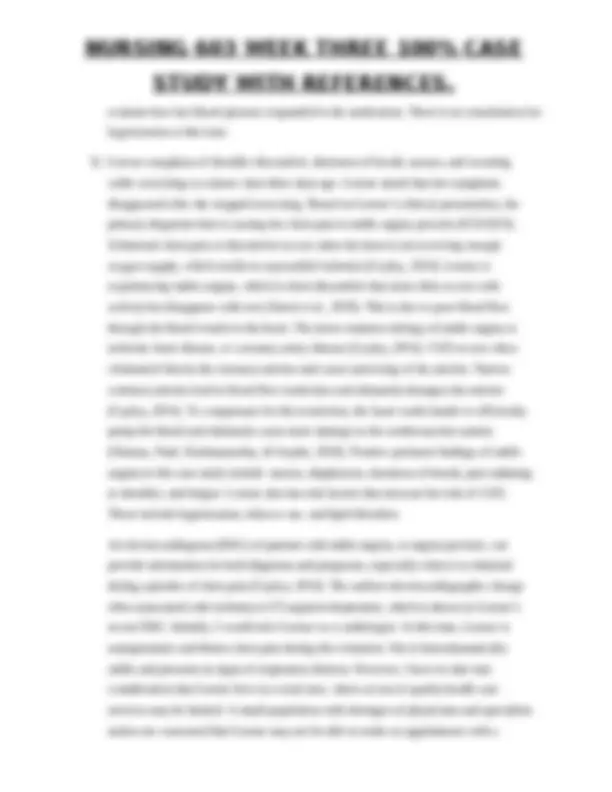

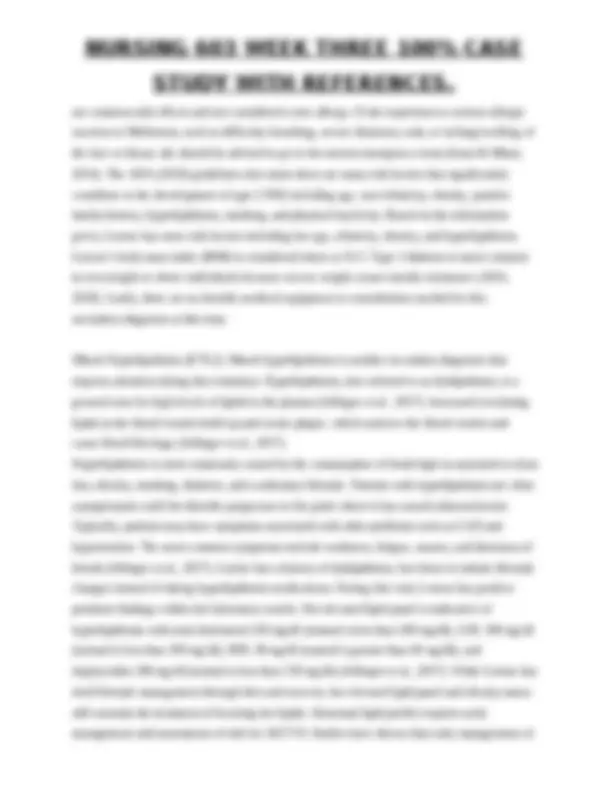

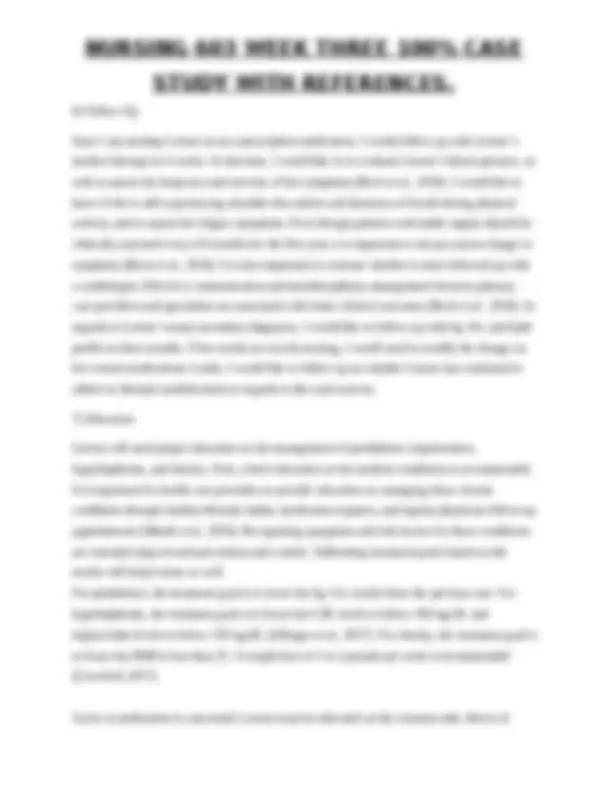
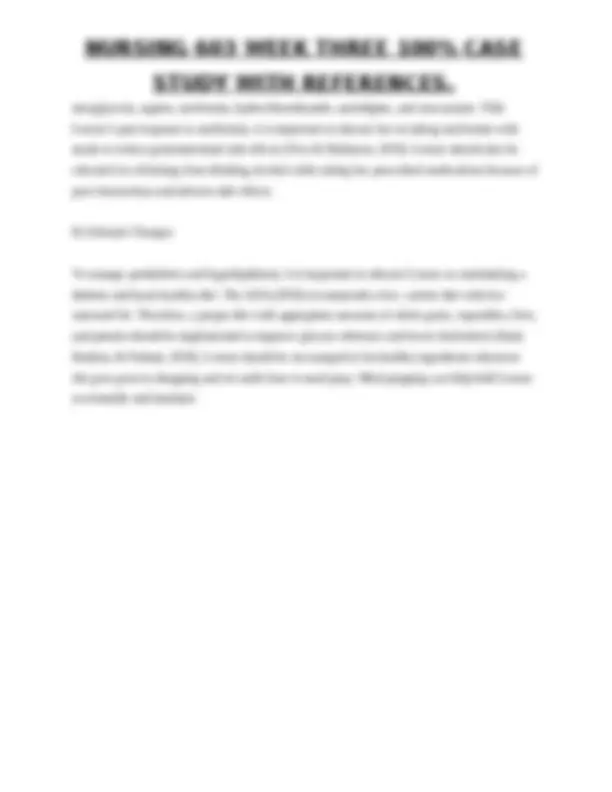
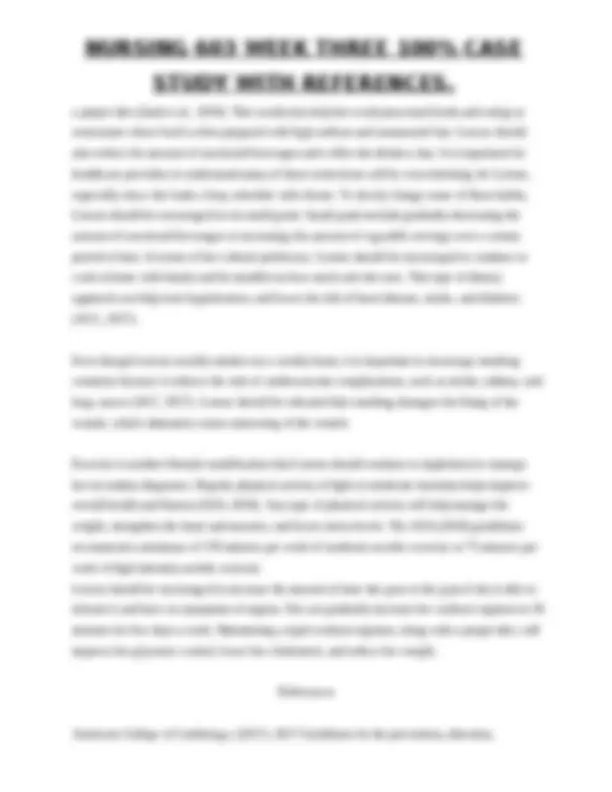
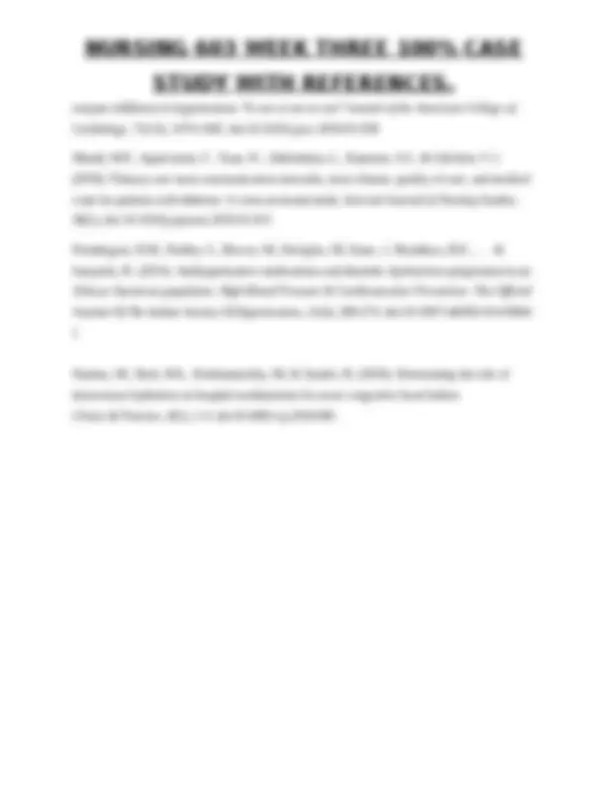
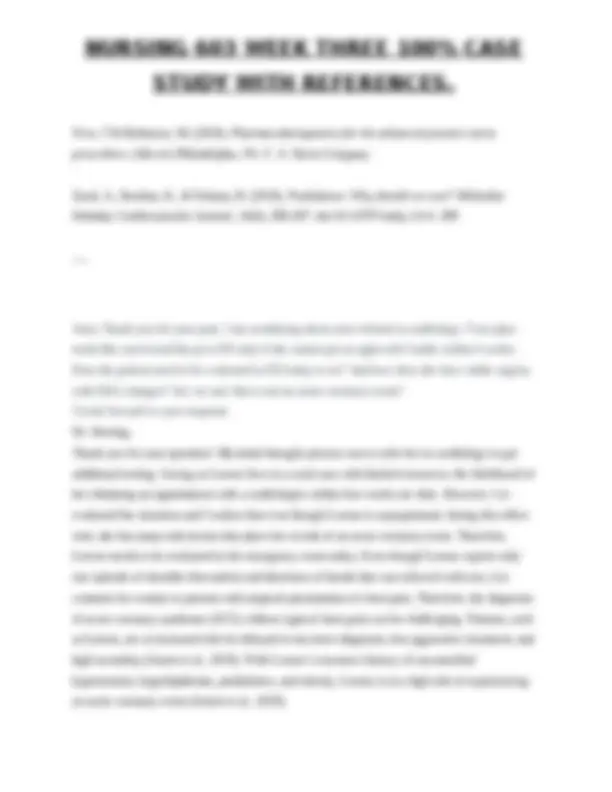

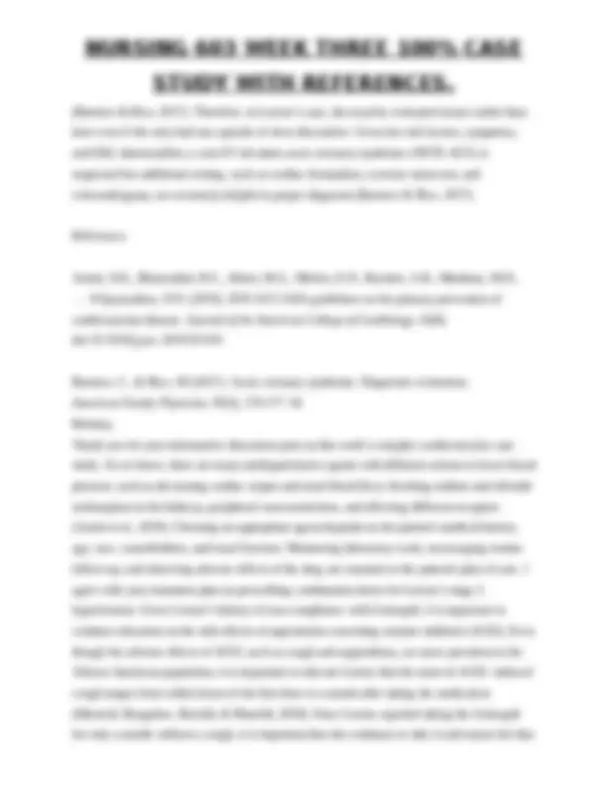

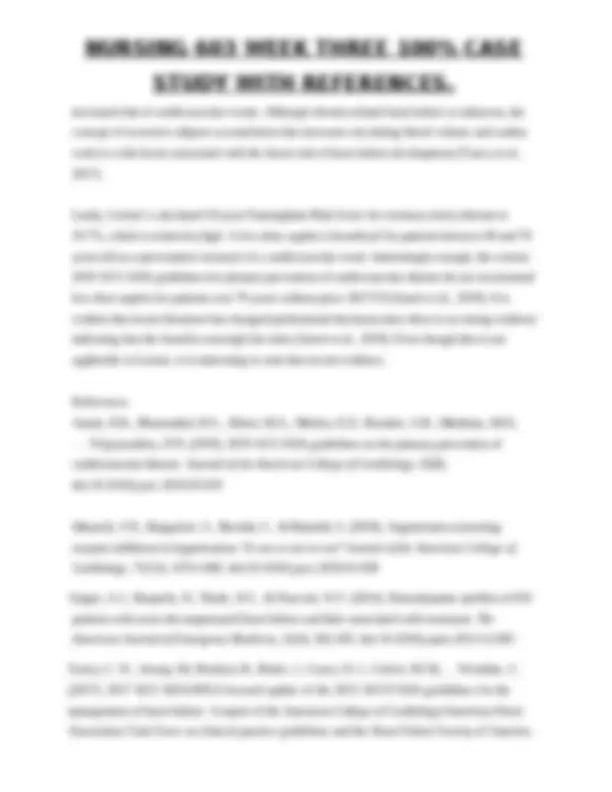

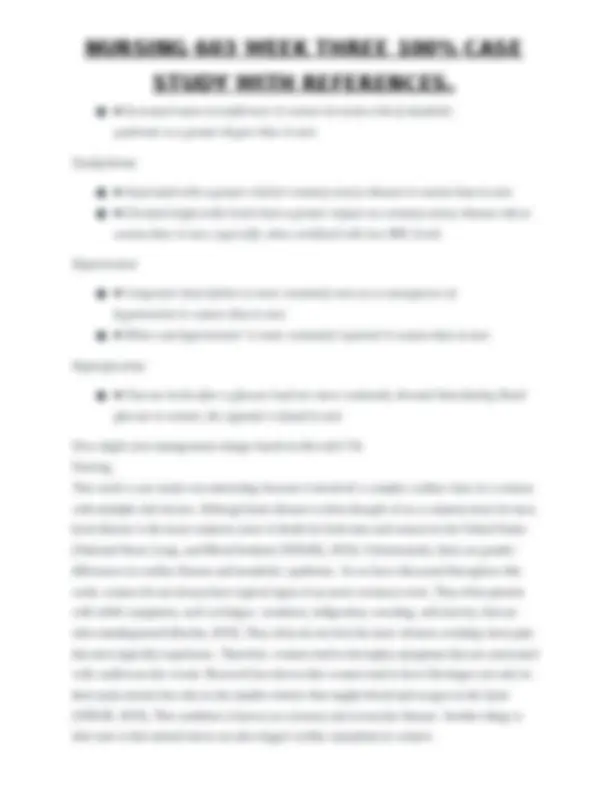

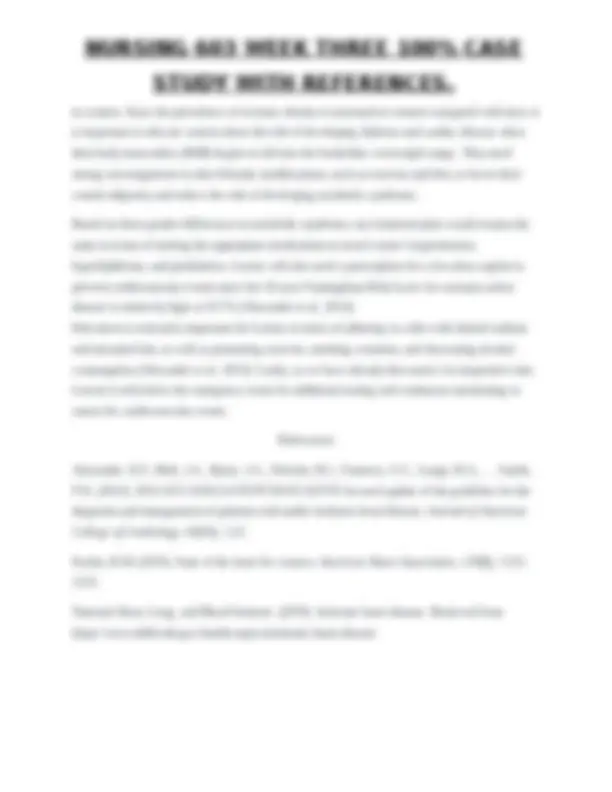


Study with the several resources on Docsity

Earn points by helping other students or get them with a premium plan


Prepare for your exams
Study with the several resources on Docsity

Earn points to download
Earn points by helping other students or get them with a premium plan
Community
Ask the community for help and clear up your study doubts
Discover the best universities in your country according to Docsity users
Free resources
Download our free guides on studying techniques, anxiety management strategies, and thesis advice from Docsity tutors
The case of lorene, a patient with hypertension, prediabetes, hyperlipidemia, obesity, and chest pain. The healthcare provider diagnoses lorene with stable angina pectoris and prescribes medications and lifestyle modifications to manage her conditions and prevent acute coronary events. The document also highlights gender differences in metabolic syndrome and risk factors for heart disease.
Typology: Exams
1 / 27

This page cannot be seen from the preview
Don't miss anything!




















Three Months Ago: AIC 6.4% Fasting glucose 135mgs/dl Total Cholesterol: 230 (200-239; borderline high) >240 very high Triglycerides 180mgs/dl (less than 150) 150-199 is borderline high Ldl 180 (<100 is normal) 130-159 is borderline high; 160-189 is very high Hdl 38 (40-59 is normal but higher is better) <40 is at increased risk of cardiac disease 5'8" weight: 220 pounds; BMI 33.5 vital signs: BP 146/90 P 70 Sao2 97% Random glucose finger stick in office: 130mgs/dl Less than 70 for LDL There’s no abnormal physical findings in the respiratory system to suggest early heart failure. But mild JVD present with trace edema in lower extremities. Eats out a lot - processed food, social drinking, occasional cigarette weekly; stopped Lisinopril one month ago, refuses HLD medication, will control with diet and exercise, allergy to METFORMIN
○ Durable Medical Equipment Diagnostic tests- discuss the goal/purpose ○ Any consultation with outside providers/services ○ Medications- discuss why you chose each specific medication
thiazide diuretic or calcium channel blocker for African American patients with diabetes (Armstrong, 2014). Calcium channel blockers have demonstrated effectiveness in the management of hypertension in the African American population (Prendergast et al., 2014). There have been recent studies that show lower responsiveness in maintaining optimal blood pressure control with the use of ACE inhibitors in the African American population (Prendergast et al., 2014). With Lorene’s history of prediabetes, hypertension, hyperlipidemia, obesity, and ethnicity, I would prescribe Lorene a thiazide diuretic such as hydrochlorothiazide 12.5 mg orally once daily, and a calcium channel blocker, such as amlodipine 5 mg orally once a day. The only durable medical equipment I would recommend for hypertension is a blood pressure machine. Lorene should be encouraged to keep a daily log and record her blood pressure readings. She should bring the log at the next follow-up appointment in three months to
evaluate how her blood pressure responded to the medication. There is no consultation for hypertension at this time.
cardiologist will also see Lorene in the emergency room and evaluate whether she will need immediate cardiac catheterization, a procedure used to diagnose and treat cardiovascular conditions. Before Lorene goes to the emergency room, I would encourage Lorene to make a follow-up appointment with the cardiologist if she is evaluated as stable. She will then be able to undergo additional testing, such as an echocardiogram (ECHO) to better visualize the chambers of the heart, and an exercise stress test, which monitors how the blood vessels in the heart works during physical activity (Cayley, 2014). Exercise EKG is more sensitive and specific than the resting EKG in detecting myocardial ischemia (Cayley, 2014). The goal of these tests is to detect possible heart-related cause of Lorene’s symptoms such as shortness of breath, chest pain, diaphoresis, and lightheadedness. At this time, I would also prescribe Lorene a nitrate, such as nitroglycerin 1 sublingual at onset of acute angina pain, which is the most effective therapy for acute angina by relaxing vascular smooth muscle (Cayley, 2014). Nitroglycerin sublingual can be repeated every 5 minutes up to 15 minutes. If the pain is unrelieved after 15 minutes, Lorene must be instructed to go to the emergency room. Lastly, I would prescribe a low dose aspirin 81 mg orally once daily for atherosclerotic cardiovascular disease (ASCVD) prevention (Arnett et al., 2019). Aspirin helps prevent platelet aggregation, reduces the risk of clot build-up and prevent blood blockage. Lastly, if Lorene is able to see a cardiologist within a month, I would strongly encourage her to seek emergency treatment if she develops more frequent episodes of shortness of breath and chest pain at rest.
normal range (greater than 100 mgs/dl). According to the American Diabetes Association (ADA, 2018) guidelines, a repeat hg A1c or a fasting plasma glucose (FPG) and a 2-hour plasma glucose (PG) should be obtained to confirm a type 2 DM diagnosis. If two different tests (such as A1C and FPG) are both above the diagnostic threshold, the diagnosis of type 2 DM is confirmed. Therefore, I would repeat a hb A1c and fasting plasma glucose on Lorene today as a follow up to her three month lab results. A high fasting blood sugar is only accurate at the moment, whereas a hemoglobin A1c measures overall blood sugar control in the past two to three months (Crawford, 2017). If the results are indicative of type 2 DM, I would prescribe Metformin ER 500 mg tablets by mouth twice daily because biguanides are the first line drug therapy for type 2 DM (ADA, 2018). I would educate Lorene about the potential side effects of Metformin, which include nausea, vomiting, bloating, gas, and abdominal pain (Irons & Minze, 2014). Lorene must understand that the gastrointestinal symptoms she was experiencing when she took Metformin in the past
hyperlipidemia reduces the risk of cardiovascular disease and decrease mortality and disease progression among patients with clinical ASCVD (Jellinger et al., 2017). Since most patients with hyperlipidemia are asymptomatic, it is important to understand the significant role of screening in the treatment and prevention of both hyperlipidemia and cardiovascular disease. Therefore, I would prescribe atorvastatin 40 mg by mouth at bedtime because statins are the primary drugs to reduce LDL levels (Jellinger et al., 2014. The decision to treat hyperlipidemia is based on the patient’s risk of atherosclerosis, which includes the patient’s lipid levels as well as other risk factors for developing atherosclerosis. Targeted LDL levels should be less than 100 mg/dL for patients with 2 or more risk factors and a 10-year risk of heart disease of 10-20% (Jellinget et al., 2017). Statin therapy can reduce LDL by 50% in diabetic patients who are 40 years of age (ADA, 2018). Lorene
has a few risk factors, including advanced age, increased lipid levels, and obesity. Therefore, she would benefit from statin therapy, which significantly reduces cardiovascular events in patients with diabetes (ADA, 2018). Since Lorene’s latest lipid profile is from three months ago, I would order a follow-up lipid profile during this visit to see if her results have changed based on her dietary modifications. If the lipid profile results remain elevated, a prescription for atorvastatin 40 mg orally once a day will be beneficial for Lorene. At this time, she does not require any medical equipment or additional consultations for this secondary diagnosis. Obesity (E66.9): Obesity is another secondary diagnosis that requires Lorene’s attention. Obesity is a disorder that involves excessive adipose tissue that increases the risk of health problems. It is often defined by a BMI of 30 kg/m2 or weight above the 95th percentile on the growth chart (Ankuda et al., 2017). The cause of obesity is primarily due to calorie intake that extends beyond the body’s metabolic needs. Lorene is considered obese since her current BMI is 33.5 kg/m2. Obesity results from a combination of causes and contributing factors, such as genetics, dietary patterns, physical inactivity, and medication use (Ankuda et al., 2017). Even though Lorene has tried to make some dietary changes, she admits eating processed foods whenever she is with her clients. She also states that it is difficult for her to prepare healthy foods since food is a large part of her culture. At this time, I would not consider any medications for obesity. The mainstay treatment for obesity is lifestyle changes such as diet and exercise. There is no additional diagnostic testing for obesity at this visit. Her BMI measurement is based on Lorene’s height and weight, which can be obtained with a scale. Lorene has been going to the gym with her daughter twice a week and has lost 2 inches around the abdomen. Since she has taken initiatives to promote weight loss, I do not feel the need to encourage any consultation unless she is interested in seeing a registered dietician. A registered dietician can help improve and promote proper nutrition therapy for patients who want to lose weight (Ankuda et al., 2017). A registered dietician can help discuss various ways to lose weight through simplified meal plans, behavior strategies, carbohydrate counting, and nutrition education (Ankuda et al., 2017). They can also provide therapeutic and counseling services to help Lorene manage her health conditions. Portion control and choosing nutritious food items can help control blood glucose levels and
nitroglycerin, aspirin, metformin, hydrochlorothiazide, amlodipine, and atorvastatin. With Lorene’s past response to metformin, it is important to educate her on taking metformin with meals to reduce gastrointestinal side effects (Woo & Robinson, 2016). Lorene should also be educated on refraining from drinking alcohol while taking her prescribed medications because of poor interactions and adverse side effects.
evaluation, and management of high blood pressure in adults. Retrieved from https://www.acc.org/~/media/Non-Clinical/Files-PDFs-Excel-MS-Word- etc/Guidelines/2017/Guidelines_Made_Simple_2017_HBP.pdf American Diabetes Association. (2018). American Diabetes Association: Standards of medical care in diabetes-2018. Retrieved from https://diabetesed.net/.../12/2018-ADA- Standards-of-Care.pdf Ankuda, C.K., Harris, J., Ornstein, K., Levine, D.A., Langa, K.M., & Kelley, A.S. (2017). Caregiving for older adults with obesity in the United States. Journal of the American Geriatrics Society, 65( 9), 1939-1945. Armstrong, C. (2014). JNC 8 guidelines for the management of hypertension in adults.
American Family Physician, 90( 7), 503-504. Arnett, D.K., Blumenthal, R.S., Albert, M.A., Michos, E.D., Buroker, A.B., Miedema, M.D.,
... Wijeysundera, D.N. (2019). 2019 ACC/AHA guideline on the primary prevention of cardiovascular disease. Journal of the American College of Cardiology, 43( 8). doi:10.1016/j.jacc.2019.03. Buch, V., Hayley, R., Salas, J., Hauptman, P.J., Davis, D., & Scherrer, J.F. (2018). Chest pain, atherosclerotic cardiovascular risk, and cardiology referral in primary care. Journal of Primary Care & Community Health, 9. doi: 10.1177/ Cayley, W.E. (2014). Diagnosing the cause of chest pain. American Family Physician, 72( 10), 2012-2021. Crawford, K. (2017). Review of 2017 diabetes standards of care. Nursing Clinics of North America, 52(4), 621-663. https://doi.org/10.1016/j.cnur.2017.07. Goroll, A., & Mulley, A. (2014). Primary care medicine: Office evaluation and management of the adult patient. (7th ed.) Philadelphia, PA: Lippincott Wlliams & Wilkins Irons, B.K., & Minze, M.G. (2014). Drug treatment of type 2 diabetes mellitus in patients for whom metformin is contraindicated. Diabetes, Metabolic Syndrome, and Obesity: Targets and Therapy, 7 , 15-24. doi:10.2147/DMSO.S Jellinger, P. S., Handelsman, Y., Rosenblit, P. D., Bloomgarden, Z. T., Fonseca, A. V., Grunberger, G.,... Davidson, M. (2017). Guideline for the management of dyslipidemia and prevention of cardiovascular disease. American Association of Clinical Endocrinologists, 23( 3), 1-87. Messerli, F.H., Bangalore, S., Bavishi, C., & Rimoldi, S. (2018). Angiotensin-converting
Woo, T & Robinson, M. (2016). Pharmacotherapeutics for the advanced practice nurse prescribers. (4th ed.) Philadelphia, PA: F. A. Davis Company Zand, A., Ibrahim, K., & Patham, B. (2018). Prediabetes: Why should we care? Methodist Debakey Cardiovascular Journal, 14( 4), 289-297. doi:10.14797/mdcj-14-4- 289 Amy, Thank you for your post. I am wondering about your referral to cardiology. Your plan reads like you'd send the pt to ED only if she cannot get an appt with Cardio within 4 weeks. Does the patient need to be evaluated in ED today or no? And how does she have stable angina with EKG changes? Are we sure this is not an acute coronary event? I Look forward to your response. Dr. Deering, Thank you for your question! My initial thought process was to refer her to cardiology to get additional testing. Seeing as Lorene lives in a rural area with limited resources, the likelihood of her obtaining an appointment with a cardiologist within four weeks are slim. However, I re- evaluated the situation and I realize that even though Lorene is asymptomatic during this office visit, she has many risk factors that place her at risk of an acute coronary event. Therefore, Lorene needs to be evaluated in the emergency room today. Even though Lorene reports only one episode of shoulder discomfort and shortness of breath that was relieved with rest, it is common for women to present with atypical presentation of chest pain. Therefore, the diagnosis of acute coronary syndrome (ACS) without typical chest pain can be challenging. Patients, such as Lorene, are at increased risk for delayed or incorrect diagnosis, less aggressive treatment, and high mortality (Arnett et al., 2019). With Lorene’s extensive history of uncontrolled hypertension, hyperlipidemia, prediabetes, and obesity, Lorene is at a high risk of experiencing an acute coronary event (Arnett et al., 2019).
Stable angina, which is often a symptom of coronary artery disease, is when an individual experiences a brief episode of chest discomfort that disappears with rest. The chest discomfort is due to poor flow through the blood vessels in the heart (Arnett et al., 2019). It is important to note that a normal resting EKG is not uncommon in patients with angina regardless of severity. However, that does not exclude the diagnosis of ischemia. In this particular case study, Lorene’s resting EKG shows ST depression in areas of the heart that are not receiving enough oxygenation. Regardless of stable or unstable coronary artery disease, ST-segment depression is associated with an increased risk of subsequent cardiac events (Barstow & Rice, 2017). Based on the leads with ST depression in Lorene’s EKG results, there may be a possible blockage of the left main coronary artery that supplies blood and oxygen to the heart. The ischemia within the inferior and anterolateral areas of the heart warrants immediate attention